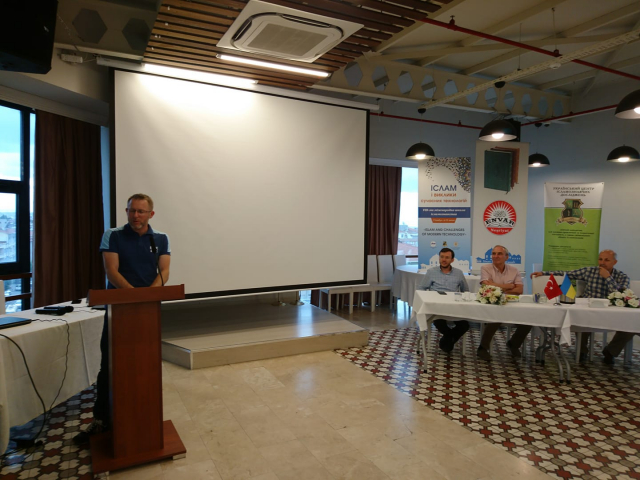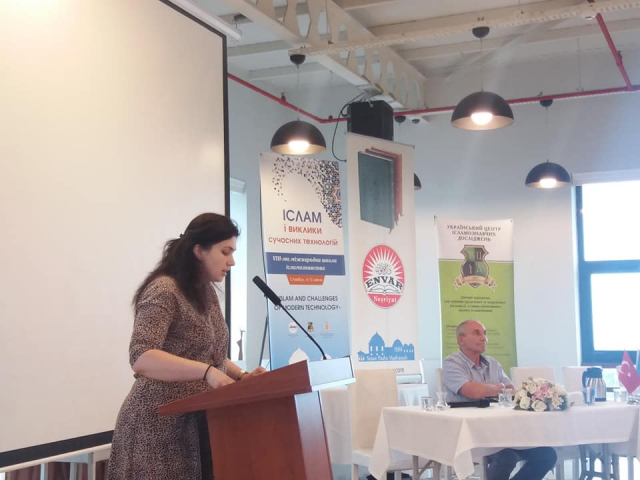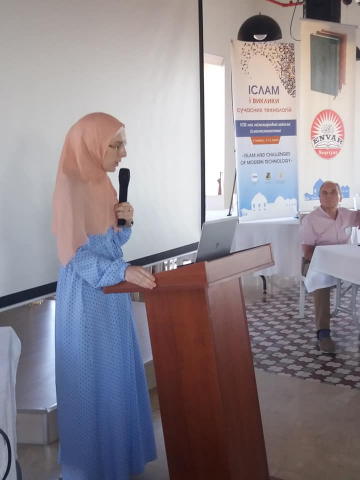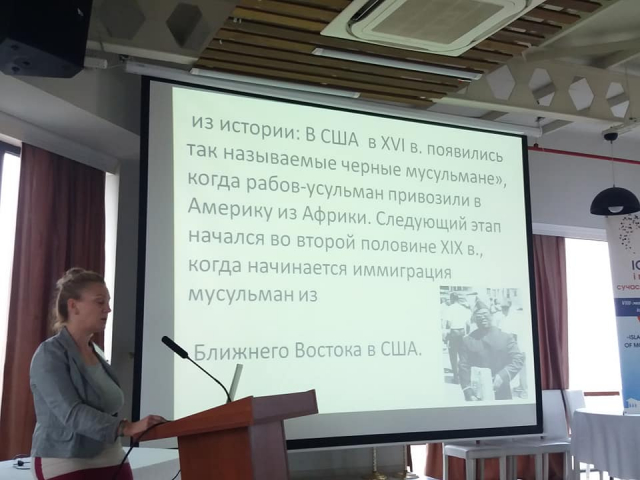A four-day research and discussion session of VIII International School of Islamic Studies consisted of both lectures and reports. Timeliness of the topics presented derives from the fact that Q&A sessions often developed into active discussions where the researchers collectively developed new ideas and offered solutions to some of the problems.
At the same time, the participants’ lectures and reports were in many ways complementary, regardless if they were delivered on the same day — sometimes the organisations put complementary topics on different days on purpose, in order to give the participants some time to get into it. For one, Mufti Said Ismagolov’s lecture on past and present of Muslim communities in Ukraine during the first plenary day, where he presented thorough analysis of different Muslim organisations and their representation in the Ukrainian Media landscape — while on the last, fourth, plenary day Deputy director of Department of Enthnicities and Religions of the Ministry of Culture of Ukraine Ms.Larysa Vladychenko presented the structure of Ukrainian Muslim communities as seen by the state officials, and gave some official statistics.
On her part, Ms.Ulvie Ablaieva added some historical context, having told about the spiritual and material culture of Crimean Tatars between XIV century and 1944 (the year where the whole people were deported to Central Asia).
Mr.Ihor Kozlovskyy spoke about Sufism in Turkey and its influence on views of a prominent Turkish thinker Said Nursi (and even the participants who were well aware of his life and legacy had something new to learn from that lecture), while Mr.Oleh Yarosh spoke about past and present of Turkish Sufi communities in the West (he specifically researched so-called “hybrid communities”, for which read the communities who both maintained ties with turkey and at the same time newcomers-oriented).
The participants also spoke about the correlation of theological and secular disciplines. Mr.Vitalii Overko spoke about global environmental problems from the prospect of God’s promise in the Holy Qur’an to provide for mankind with enough resources, no matter how large the population. Mr.Omer Korchak in his lecture “How to Read the Book of Universe” drew everyone’s attention to certain patterns in the structure of everything surrounding humankind, as well as of the humankind, revealing the greatness of the Creator and the perfection of the patterns set by him. Mr.Muhammad Seid gave a thorough analysis of the main stages of mankind’s civilizational evolution from both the materialistic and the Qur’anic prospects and noted that one has to look beneath the surface and see that. For instance. Prophet David (peace be upon him) not only had access to the front-edge technologies of his time, but also possessed civilizational vision of his people’s future. With that, both David himself and his son Suleiman (peace be upon them) had plenty of technical knowledge (Suleiman could even travel long distances in short periods of time using “the force of wind”, as we today do with planes!), yet they never forget to be grateful to God, for they fully realized that all that was from his generosity rather than their personal achievements.
Mr.Riza Derındağ spoke about the purpose of life of a human from Islamic prospect, while Mr. Abdullah Gökhan Akar from marmara University drew the participants’ attention to an interesting peculiarity of the Holy Qur’an, namely the hints to the limits of scientific progress available for humans to discover left all over the text. He also mentioned the example of Prophet Suleiman and the “power of wind” that helped him cover great distances in a short time, but the researcher himself (Mr. Akar has an engineering degree in telecommunications) got inspired by the possibility of transmitting scents to great distances, derived from the story of Prophet Joseph (his father could sense his scent a month-long distance away - so he dedicated his thesis to solving that task. Mr. Akar believed that the most promising lead was sending impulses to the receiver’s brain directly, so one could sense the scent that wasn’t physically present around them.
There was a separate pool for the modern Media. Professor Alla Boyko spoke about coverage of Islam-related topics in the Ukrainian media and combating sstereotypes — the report that initiated plenty of discussion on problems of religion-related journalism and means of solving those problems. The discussion was relatably continued by Ms.Viktoria Nazaruk’s report on religious stereotypes in the Media, where the participants discussed the importance of keeping up to recognized journalistic standards such as BBC guidebooks, and of having means to control the maintenance of such standards by the Media.
The problem of ground theological education for not just journalists, but for every humanitarian student, was further developed by Mr.Hennadii Khrystorkin, who not only described the practical problems of implementing respective educational programmes, but also introduced some ways of solving them. The problem of relations with the Media got further development in Ms.tetiana Iastremska’s “Islam and Interfaith Dialogue in the Era of the New Media”. They also spoke about developing academic programmes for religious studies and about the necessity of implementing such a programme in every curriculum in order to increase interfaith cohesion in the society.
Mr.Vadym Sliusar, on his part, spoke about the specifics of the Advertisement in predominantly Muslim countries, examplified by Turkish Ads.
The School’s participants eagerly discussed both Islamic thinkers (and their ideas) and their depiction by Non-Muslim authors. Mr.Mykhailo Yakubovych spoke about moderation and reforms in the legacy of Eastern-European thinkers Ismail Gasprinskii, Muhammad Asad and Alija Izetbegovic. When bringing his lecture to the conclusion, he noted that he chose those three thinkers for they represented thoughts understandable for their communities, while most of the modern thinkers were unable to promote the good and the right just because they were mentally distant from their communities.
Professor Oleksandr Sahan spoke about state activity and legacy of Suleyman I Kanuni (“the Legislator”), while Ms.Solomiia Vivchar spoke about unbiased Islamic Studies of Ivan Franko (with his “oriental” pieces highly appreciated by, in particular, his friend, reviewer and co-author Agatanhel Krymsii).
The programme also included a pool of topics on religiosity and interfaith relations in the modern world (which also to some extent covered the problem of media influence on religious and interfaith processes). In particular, Polish professor Mariusz Marszewski, when speaking of genocide of Rohinja Muslims, pointed out that there was a lot of compassion towards Rohinja refugees in his country, Poland, when even racists and islamophobes if ever there was one agreed that those people should be let in the country, and the prominent role in that opinion belonged to the TIME magazine cover depicting Ashin Wirathu, a Buddist Monk who inspired anti-Muslim movement and bashing, with a headline "The Face of Buddhist Terror" (and the article itself labeled him as “Buddist Bin Laden”).
Ms.Vita Tytarenko spoke about the forecasts and trends of coexsistence of Christianity and Islam in the nearest future; Ms.Olga Gold spoke about Islam in the present-day USA; and. Ms. Oksana Horkusha spoke about the challenges in prospects for traditional religions (Islam in particular) in terms of predominant utilitarianism in present-day Ukraine. The topic of prozelytizm and of reasons bringing neofites to Islam was covered by Mr.Seifulla Rashidov.
Ms.Bohdana Sypko delivered an extremely interesting research, and, when speaking about the Muslim characters in the books of a French novelist Jean-Christophe Grangé, gave an insight in historical context of the situations depicted, which led to thorough analysis and discussion on post-colonialism issues.





